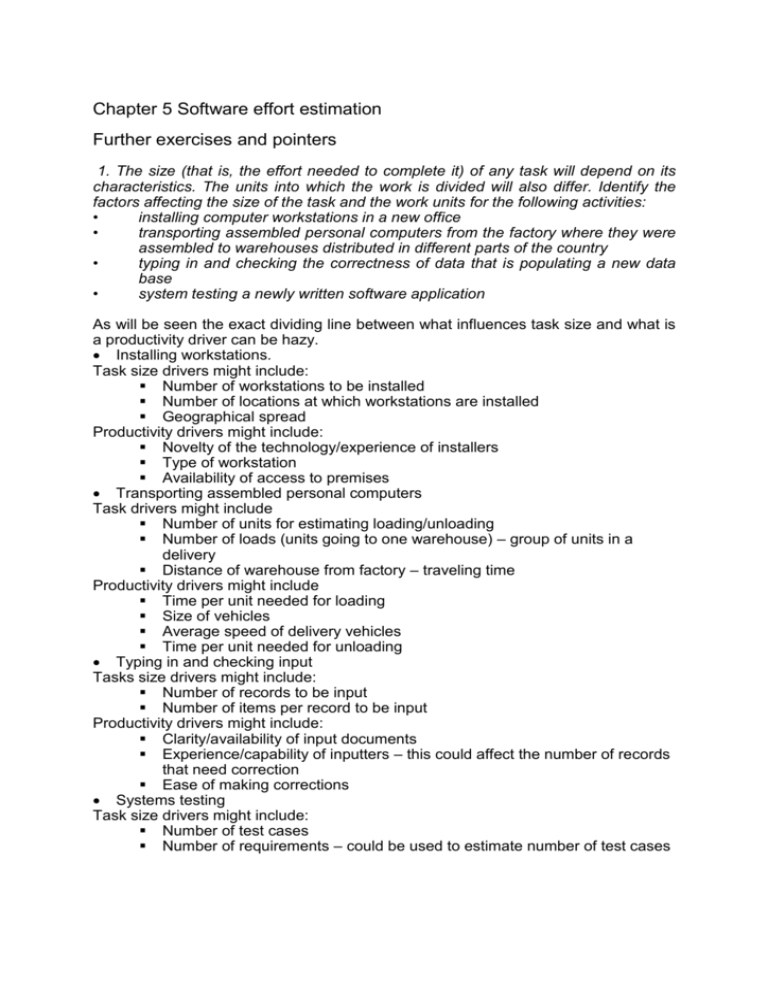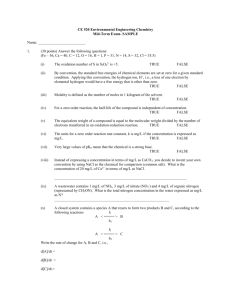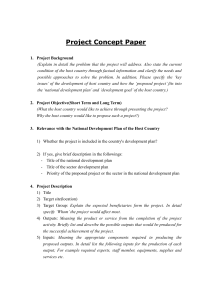Chapter 5 Selection of an appropriate project approach
advertisement

Chapter 5 Software effort estimation Further exercises and pointers 1. The size (that is, the effort needed to complete it) of any task will depend on its characteristics. The units into which the work is divided will also differ. Identify the factors affecting the size of the task and the work units for the following activities: • installing computer workstations in a new office • transporting assembled personal computers from the factory where they were assembled to warehouses distributed in different parts of the country • typing in and checking the correctness of data that is populating a new data base • system testing a newly written software application As will be seen the exact dividing line between what influences task size and what is a productivity driver can be hazy. Installing workstations. Task size drivers might include: Number of workstations to be installed Number of locations at which workstations are installed Geographical spread Productivity drivers might include: Novelty of the technology/experience of installers Type of workstation Availability of access to premises Transporting assembled personal computers Task drivers might include Number of units for estimating loading/unloading Number of loads (units going to one warehouse) – group of units in a delivery Distance of warehouse from factory – traveling time Productivity drivers might include Time per unit needed for loading Size of vehicles Average speed of delivery vehicles Time per unit needed for unloading Typing in and checking input Tasks size drivers might include: Number of records to be input Number of items per record to be input Productivity drivers might include: Clarity/availability of input documents Experience/capability of inputters – this could affect the number of records that need correction Ease of making corrections Systems testing Task size drivers might include: Number of test cases Number of requirements – could be used to estimate number of test cases Items to be input, items output per test case Productivity drivers might include: Ease of test set up Errors found – this will require retesting Availability of test automation tools 2. If you were asked as an expert to provide an estimate of the effort needed to make certain changes to an existing piece of software, what information would you like to have to hand to assist you in making that estimate? The estimation of the effort to change a software component requires a different approach to the development of completely new software as a major factor is the structure of the existing software. The estimator might need to know: The nature of the changes required Ideally they should be told about the reasons for the change, as they may be able to suggest alternatives and more economic ways of meeting the requirement The structure of the software to be changed Some idea of which parts of the software need changing Who will be carrying out the changes – will it be someone who is already familiar with the software to be changed, or will additional time have to be allocated for familiarization? 3. A small application maintains a telephone directory. The database for the application contains the following data types: Staff reference Surname Forenames Title Department code Room number Telephone extension E-mail address Fax number Transactions are needed which: i) set up new entries; ii) amend existing entries iii) delete entries iv) allow enquirers to list on line the details for a particular member of staff v) produce a complete listing of the telephone directory entries in alphabetical order a) Use this scenario to produce an estimated Mark II FP count. List all the assumptions you will need to make. b) Another requirement could be to produce the listing in (v) in departmental order. In your view should this increase FP count and if so by how much? a) transaction set up entry inputs new staff reference to fax number in data type list amend (display) staff reference amend (update) delete entry enquiry listing totals grand total outputs 9 error message 1 entities accessed directory entry 1 surname to fax number or error message error message surname, forenames (as check) error message full details + error message full details 33 x 0.26=8.58 9 directory entry 1 1 directory entry 1 3 directory entry 1 10 directory entry 1 9 directory entry 7x 1.66 =11.62 1 surname to fax 8 number staff reference 1 staff reference 3 or surname, forenames trigger 1 23 x 0.58 = 13.34 1 33.54 b) It can argued that the data presented in the two reports are the same, so that they are logically the same and so should be counted only once. Most development environments have easy to use features for sorting data and so the actual amount of work needed to produce the second report would probably be negligible. However, if you have every tried to look up details in an unsorted list, the fact that it is sorted can provide considerable value. There is therefore a debate among FP practitioners about whether FPs should reflect the value of the system to the user or the amount of work that is needed to develop it. This is particularly an issue in relation to the question of reusable components. 4. The following details are held about previously developed software modules. module inputs entity outputs days types accesse d a 1 2 10 2.60 b 10 2 1 3.90 c 5 1 1 1.83 d 2 3 11 3.50 e 1 3 20 4.30 A new module has 7 inputs, one entity type access and 7 outputs. Which of the modules a to e is the closest analogy in terms of Euclidean distance? module inputs entity types accessed outputs days euclidean distance from new a 1 2 10 2.6 6.78 b 10 2 1 3.9 6.78 c 5 1 1 1.83 6.32 d 2 3 11 3.5 6.71 e 1 3 20 4.3 14.46 new 7 1 7 Module c would appear to provide the best analogy as it is at the least Euclidean distance from the new module. This provides a base estimate of 1.83 days 5. Using the data in further exercise 4 above, calculate the Simons Mark II FPs for each module. Using the results, calculate the effort needed for the new module described in additional exercise 4. How does this estimate compare to the one based on analogy? module inputs outputs days 1 10 5 2 1 entity types accesse d 2 2 1 3 3 a b c d e totals 10 1 1 11 20 2.6 3.9 1.83 3.5 4.3 (a) days 16.13 7 1 7 new FPs (c) productivity FPs /per day (b/a) new estimate for new (c/(b/a)) FPs 6.50 9.38 4.82 9.00 10.76 (b) fps 40.46 2.51 7.54 3.01 Note that this is higher than that estimate given in 4. Partly this is because the new project may be closest to module c but it is bigger in terms of the number of inputs and outputs that it has. It also has an estimate bigger than that for module a because Mark II FPs assume that input procedures are more difficult to implement than outputs and therefore gives them a higher weighting. 6. Given the project data below: projec inputs output entity t s accesses system users program developer -ming days languag e 1 210 420 40 10 x 30 2 469 1406 125 20 x 85 3 513 1283 76 18 y 108 4 660 2310 88 200 y 161 5 183 367 35 10 z 22 6 244 975 65 25 z 42 7 1600 3200 237 25 y 308 8 582 874 111 5 z 62 X 180 350 40 20 y Y 484 1190 69 35 y Note X and Y are new projects for which estimates of effort are needed. a) What items are size drivers? inputs, outputs, entity accesses (system users for certain aspects) – the more of these there are the larger the development job b) What items are productivity drivers? Programming language – the number of lines of code that can be produced in a day will depend, in part, on the programming language c) What are the productivity rates for programming languages x, y and z? x 10 FPs a day y 7 FPs a day z 12 FPs a day d) What would be the estimated effort for projects X and Y using a Mark II function point count? project inputs outputs entity accesses system users 1 2 210 469 420 1406 40 125 3 4 7 513 660 1600 1283 2310 3200 76 88 237 5 183 367 35 10 20 sub-totals productivity (FPs/day) 18 200 25 sub-totals productivity (FPs/day) 10 programming language x x developer days FPs 30 85 115 9.9 297.4 845 1142.4 y y y 108 161 308 577 7.0 757.15 1129.48 2153.42 4040.05 z 22 259.66 6 8 X Y 244 582 975 874 65 111 25 5 sub-totals productivity (FPs/day) z z 180 484 350 1190 40 69 20 35 y y 42 62 126 12.0 502.92 749.06 1511.64 261.8 704.66 The above table gives the FP counts. Using the productivity rate for programming language y, the estimate for Project X would be 262/7 i.e. 37 days, and for Project Y 705/7 i.e. 101 days e) What would be the estimated effort for X and Y using an approximate analogy approach? Project X seems closest to Project 5 which provides an estimate of 22 days, and Project Y seems to be closest to Project 3 which gives an estimate of 108 days . f) What would have been the best estimating method if the actual effort for X turns out to be 30 days and for Y turns out to be 120 days? Can you suggest why the results are as they are and how they might be improved. If we use a measurement based on the percentage error, calculated as absolute (actual-estimate)/actual we get the following: Project X Project Y FP method 23% 16% analogy 27% 10% This illustrates that no one estimating method can be assumed to be the most accurate in all cases. The analogy estimate for Project X might have been improved by adjusting for the fact that Project X is to be written in programming language y while Project 5 was written in programming language z 7. A report in a college time-tabling system produces a report showing the students who should be attending each time-tabled teaching activity. Four files are accessed: the STAFF file, the STUDENT file, the STUDENT-OPTION file and the TEACHINGACTIVITY file. The report contains the following information: Teaching activity reference Topic name Staff forenames Staff surname Title Semester (1 or 2) Day of week Time Duration Location For each student: student forename student surnames Calculate the Mark II FPs that this transaction would generate. Can you identify the factors that would tend to make the two methods generate divergent counts? Mark II Inputs Entity accesses Outputs Total 1 ( a trigger) x 0.58 = 4 x 1.66 = 12 x 0.26 = 0.58 6.64 3.12 10.34







